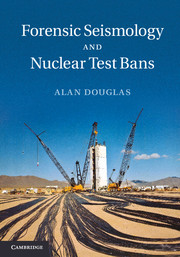Book contents
- Frontmatter
- Contents
- Preface
- Abbreviations and mathematical symbols
- Prologue
- 1 Seismology: ancient and modern
- 2 Statistical solutions to seismological problems
- 3 Seismograms as time series
- 4 Seismographs and seismograms
- 5 Seismometer arrays and processing methods
- 6 Seismogram interpretation and synthesis
- 7 Hypocentres and P travel times
- 8 Seismic magnitudes
- 9 Seismic source identification
- 10 Epilogue
- Appendix A P and S radiation from a double-couple source
- Appendix B Normal equations for analysis of variance
- Appendix C Some uses of the FFT
- Appendix D Anelastic attenuation
- Appendix E The relation of the transient and steady-state responses
- Appendix F Seismometer–galvanometer systems
- Appendix G SNI from summing array recordings
- Appendix H The equations for computing MP filters
- Appendix I Circular arrays
- Appendix J Geometrical spreading when S reflects as sP
- Appendix K The Fourier integral for a dispersed wave train
- Appendix L Tables of explosions and earthquakes
- Appendix M Album of body-wave seismograms
- Appendix N Exercises
- References
- Further reading
- Author index
- Index
1 - Seismology: ancient and modern
Published online by Cambridge University Press: 05 March 2013
- Frontmatter
- Contents
- Preface
- Abbreviations and mathematical symbols
- Prologue
- 1 Seismology: ancient and modern
- 2 Statistical solutions to seismological problems
- 3 Seismograms as time series
- 4 Seismographs and seismograms
- 5 Seismometer arrays and processing methods
- 6 Seismogram interpretation and synthesis
- 7 Hypocentres and P travel times
- 8 Seismic magnitudes
- 9 Seismic source identification
- 10 Epilogue
- Appendix A P and S radiation from a double-couple source
- Appendix B Normal equations for analysis of variance
- Appendix C Some uses of the FFT
- Appendix D Anelastic attenuation
- Appendix E The relation of the transient and steady-state responses
- Appendix F Seismometer–galvanometer systems
- Appendix G SNI from summing array recordings
- Appendix H The equations for computing MP filters
- Appendix I Circular arrays
- Appendix J Geometrical spreading when S reflects as sP
- Appendix K The Fourier integral for a dispersed wave train
- Appendix L Tables of explosions and earthquakes
- Appendix M Album of body-wave seismograms
- Appendix N Exercises
- References
- Further reading
- Author index
- Index
Summary
Seismology is a stone age science
Sir (later Lord) William G. Penney, c.1959 (attributed)The long march begins
The AWE scientists who were assigned to the forensic seismology programme in the late 1950s found that although there was much theoretical work on seismic-wave propagation, experimental and observational seismology were poorly developed. The main practical interest in seismology was in the destructive effects of large earthquakes. The only useful information routinely obtained from seismograms was arrival times of the most significant seismic phases, from which epicentres and focal depths could be estimated and Earth's structure derived. Most if not all stations used drum recorders operating at low magnification with compressed time bases (maximum speed around 1 mm s−1).
The continuous background of seismic noise has little effect on observations of the waves from large earthquakes as their amplitude is much greater than that of the noise. If seismology is to provide an effective way of detecting (and ideally identifying) explosions, the recording systems in use in the 1950s were inadequate for the detection of the weak signals from tests of a few kilotons (ground motions in the 30–90° range of around 10 nm at 1Hz). Many of the seismometers did not have the required sensitivity, and responded to unwanted non-seismic disturbances such as changes of air temperature and atmospheric pressure; seismometers that had the required sensitivity were heavy and bulky and so were unsuitable for deployment as arrays.
- Type
- Chapter
- Information
- Forensic Seismology and Nuclear Test Bans , pp. 1 - 45Publisher: Cambridge University PressPrint publication year: 2013



